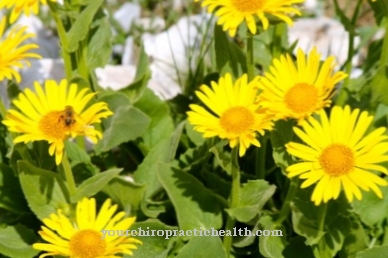The Barbara herb - or also Winter cress called - belongs to the cruciferous family. It is used as a vegetable or salad, but it also has a blood-purifying effect.
Occurrence & cultivation of the barbara herb

Barbara herb becomes about 30 to 90 cm high. In the first year the plant forms its leaves, which are lyre-shaped and have several side lobes or a heart-shaped end lobe. Its flowers are yellow and four-fold. They reach a diameter between 7 and 9 mm. The pods grow on thin stems, which reach a length of about 15 to 25 mm. The barbara herb flowers from May to June and can be found in the temperate zone worldwide.
It grows in fields, roadsides, in gravel pits or on embankments, whereby the plant prefers nitrogenous soils. You can of course also grow winter cress yourself. The herb grows well in sunny spots and likes loamy and sandy soil. The pH range should be between 4.8 and 7.5. The seeds are put into the ground about 5 centimeters apart. The area should be kept moist during germination, and the first shoots will appear after about two to three weeks.
The name of the Barbarakraut is derived from Saint Barbara, who is considered the patron saint of quarry workers and miners. Others believe that the name derives from the Latin term Carpentariorum berba comes with what Carpenterweed can be translated as the carpenters and joiners used the herb earlier on wounds and injuries. Other names for the plant are: Common watercress, Real barbarian herb, Spring barbara herb, Yellow mugwort, Rapunzel or Mustard herb.Effect & application
Barbara's herb can not only be used as a decoration in a bouquet, it is also very high in vitamin C. For this reason, the plant is used in the kitchen, where it can be prepared in the form of spinach like sorrel, ground elder or nettle. For this, the fresh leaves are harvested from October to May, they taste very spicy and are comparable to the cress, so that the barbara herb is also known as winter cress.
The sharp taste is due to the mustard oils it contains. Barbara's herb can not only be cooked, but also consumed raw. It is used, for example, in winter salads but also in herbal quark. Before the plant starts to bloom, the leaves taste very good because they are particularly tender. Then they can be chopped up and added to a salad. The older leaves are mostly bitter and harder, but can still be used as vegetables. The bitterness is reduced if the cooking water is changed several times, but the herb also loses many nutrients as a result.
It is therefore advisable to use less of the barbara herb and add other vegetables. A pesto made from Barbara's herb is also very tasty, for which the rosette leaves or the young shoots are best used. In addition to vitamin C, Barbara's herb also contains other ingredients that have a blood-purifying effect. The bitter substances it contains stimulate the metabolism and promote the production of digestive juices in the liver, gall bladder, pancreas and stomach.
The plant also has wound healing properties and can be used in the form of tinctures, extracts or infusions. In addition, Barbarakraut was also a so-called Anti-scurvy plant, a disease that developed due to a lack of vitamin C.
Importance for health, treatment & prevention
Barbara's herb is often used to prevent colds. For this, a tea is made from the leaves of the herb. To make one liter of tea, 25 grams of rosette leaves are needed. The tea has to steep for eight to twelve minutes, then two to three cups of it can be drunk throughout the day. It is also possible to use the tea in case of stomach acidity or in the course of an alkaline fast. A tincture can also be made to prevent infections in the kidney and bladder area.
For this you need the seeds of the herb, which are crushed with the help of a mortar and then mixed with wine. There they have to brew for about two weeks before they are filtered out. The tincture has a diuretic effect, but not more than three teaspoons per day should be taken. Barbara's herb can also be used for better wound healing, although the treatment applies to smaller cuts, because heavily soiled or deep wounds should always be treated by a doctor. If you want to treat an abrasion with Barbara's herb, you take the crushed leaves of the herb and put them in olive oil for a day, then the oil is filtered and the wound is dabbed with it.
The oil can also be made in advance and stored airtight and cool in a bottle. In addition, a decoction with Barbara's herb is also effective for stone diseases. These are hardenings that normally dissolve in the urine. Winter cress can be used for kidney and gallstones, whereby a tea is made from 30g fresh leaves of Barbara's herb, which is poured over with a liter of boiling water.
The tea should steep for ten minutes, then three cups can be drunk daily. Since the tea also has a diuretic effect, it can also be used for gout. Gout is triggered by an excessively high level of uric acid in the body and as a result uric acid crystals are deposited in the joints. The tea leads to an improvement in uric acid excretion and has a diuretic and sweat-inducing effect.
























.jpg)



